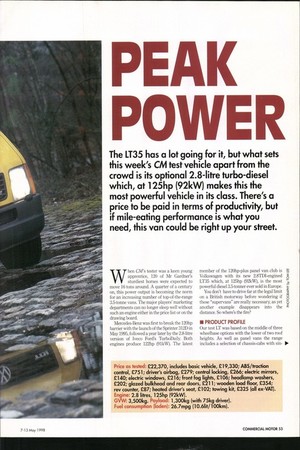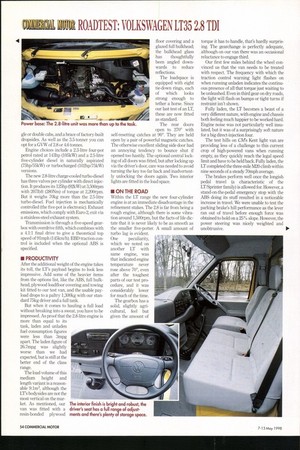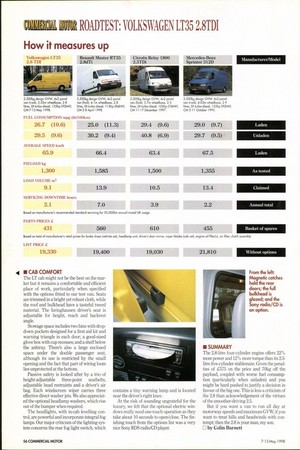PEAK P The 1135 has a lot going for it,
Page 53

Page 54

Page 56

If you've noticed an error in this article please click here to report it so we can fix it.
but what sets this week's CM test vehicle apart from the crowd is its optional 2.8-litre turbo-diesel which, at 125hp (92kW) makes this the most powerful vehicle in its class. There's a price to be paid in terms of productivity, but if mile-eating performance is what you need, this van could be right up your street.
Price as testea. £22,370, includes basic vehicle, £19,330; ABS/traction control, £751; driver's airbag, £279; central locking, £266; electric mirrors, £140; electric windows, £216; front fog lights, £106; headlamp washers, £202; glazed bulkhead and rear doors, £211; wooden load floor, £354; rev counter, £87; heated driver's seat, £102; towing kit, £325 (all ex-VAT). Engine: 2.8 litres, 125hp (92kW). GVW: 3,500kg. Payload: 1,300kg (with 75kg driver). Fuel consumption (laden): 26.7mpg (10.61it/100km). When CM'S tester was a keen young apprentice, 120 of Mr Gardner's sturdiest horses were expected to move 16 tons around. A quarter of a century on, this power output is becoming the norm for an increasing number of top-of-the-range 3.5-tonne vans. The major players' marketing departments can no longer sleep well without such an engine either in the price list or on the drawing board.
Mercedes-Benz was first to break the 120hp barrier with the launch of the Sprinter 312D in May 1995, followed a year later by the 2.8-litre version of Iveco Ford's TurboDaily. Both engines produce 122hp (91kVV). The latest member of the 120hp-plus panel van club is Volkswagen with its new 2.8TDI-engined LT35 which, at 125hp (92kW), is the most powerful diesel 3.5-tonner ever sold in Europe.
You don't have to drive far at the legal limit on a British motorway before wondering if these "supervans" are really necessary, as yet another example disappears into the distance. So where's the fire?
• PRODUCT PROFILE Our test LT was based on the middle of three wheelbase options with the lower of two roof heights. As well as panel vans the range includes a selection of chassis-cabs with sin gle or double cabs, and a brace of factory-built dropsides. As well as the 3.5-tonner you can opt for a GVW of 2.8 or 4.6 tonnes.
Engine choices include a 2.3-litre four-pot petrol rated at 143hp (105kW) and a 2.5-litre five-cylinder diesel in naturally aspirated (75hp/55kW) or turbocharged (102hp/75kW) versions.
The new 2.8-litre charge-cooled turbo-diesel has three valves per cylinder with direct injection. It produces its 125hp (92kW) at 3,500rpm with 2071bft (280Nm) of torque at 2,200rpm. But it weighs 70kg more than the 2.5-litre turbo-diesel. Fuel injection is mechanically controlled (the five-pot is electronic). Exhaust emissions, which comply with Euro-2, exit via a stainless-steel exhaust system.
Transmission is through a five-speed gearbox with overdrive fifth, which combines with a 4.1:1 final drive to give a theoretical top speed of 91mph (145km/h). EBD traction control is included when the optional ABS is specified.
• PRODUCTIVITY After the additional weight of the engine takes its toll, the LT's payload begins to look less impressive. Add some of the heavier items from the options list, like the ABS, full bulkhead, plywood loadfloor covering and towing kit fitted to our test van, and the usable payload drops to a paltry 1,300kg with our standard 75kg driver and a full tank.
The load volume of this medium height and length variant is a reasonable 9.1m3, although the LT's bodysides are not the most vertical on the market As mentioned, our van was fitted with a resin-bonded plywood floor covering and a glazed full bulkhead; the bulkhead glass has thoughtfully been angled downwards to reduce reflections.
The loadspace is equipped with eight tie-down rings, each of which looks strong enough to tether a horse. Since our last test of an LT, these are now fitted as standard.
The rear doors open to 270° with self-resetting catches at 90°. They are held open by a pair of powerful magnetic catches. The otherwise excellent sliding side door had an annoying tendency to bounce shut if opened too hastily. The optional central locking of all doors was fitted, but after locking up via the driver's door, care was needed to avoid turning the key too far back and inadvertently unlocking the doors again. Two interior lights are fitted in the load space.
• ON THE ROAD Within the LT range the new four-cylinder engine is at an immediate disadvantage in the refinement stakes. The 2.8 is far from being a rough engine, although there is some vibration around 1,500rpm, but the facts of life dictate that it is never likely to be as smooth as the smaller five-potter. A small amount of turbo lag is evident One peculiarity, which we noted on another LT with same engine, was that indicated engine temperature never rose above 70°, even after the toughest parts of our test procedure, and it was considerably lower for much of the time.
The gearbox has a solid, slightly agricultural, feel but given the amount of torque it has to handle, that's hardly surprising. The gearchange is perfectly adequate, although on our van there was an occasional reluctance to engage third.
Our first few miles behind the wheel convinced us that the van needs to be treated with respect. The frequency with which the traction control warning light flashes on when running unladen indicates the continuous presence of all that torque just waiting to be unleashed. Even in third gear on dry roads, the light will flash on bumps or tight turns if restraint isn't shown.
Fully laden, the LT becomes a beast of a very different nature, with engine and chassis both feeling much happier to be worked hard. Engine noise was not particularly well insulated, but it was of a surprisingly soft nature for a big direct-injection four.
The test hills on CMs Kent light van are providing less of a challenge to this current crop of high-powered vans when running empty, as they quickly reach the legal speed limit and have to be held back. Fully laden, the LT completed the three-mile M20 climb within nine seconds of a steady 70mph average.
The brakes perform well once the longish pedal travel (a characteristic of the LT/Sprinter family) is allowed for. However, a stand-on-the-pedal emergency stop with the ABS doing its stuff resulted in a noticeable increase in travel. We were unable to test the parking brake's hill performance as the lever ran out of travel before enough force was obtained to hold on a 25% slope. However, the power steering was nicely weighted and unobtrusive.
II CAB COMFORT The LT cab might not be the best on the market but it remains a comfortable and efficient place of work, particularly when specified with the options fitted to our test van. Seats are trimmed in a bright yet robust cloth, while the roof and bulkhead have a tasteful tweed material. The Isringhausen driver's seat is adjustable for height, reach and backrest angle.
Stowage space includes two bins with dropdown pockets designed for a first aid kit and warning triangle in each door; a good-sized glove box with cup recesses; and a shelf below the ashtray. There's also a large enclosed space under the double passenger seat, although its use is restricted by the small opening and the fact that part of wiring loom lies unprotected at the bottom.
Passive safety is looked after by a trio of height-adjustable three-point seatbelts, adjustable head restraints and a driver's air bag. Each windscreen wiper carries three effective direct washer jets. We also appreciated the optional headlamp washers, which rise out of the bumper when required.
The headlights, with in-cab levelling control, are powerful and incorporate integral fog lamps. Our major criticism of the lighting system concerns the rear fog light switch, which contains a tiny warning lamp and is located near the driver's right knee.
At the risk of sounding ungrateful for the luxury, we felt that the optional electric windows really need one-touch operation as they take about 10 seconds to open/close. The finishing touch from the options list was a very nice Sony RDS radio/CD player. • SUMMARY The 2.8-litre four-cylinder engine offers 22% more power and 12% more torque than its 2.5litre five-cylinder stablemate. Given the penalties of e£575 on the price and 70kg off the payload, coupled with worse fuel consumption (particularly when unladen) and you might be hard pushed to justify a decision in favour of the big one. This is less a criticism of the 2.8 than acknowledgement of the virtues of the smoother-driving 2.5.
But if you want a van to run all day at motorway speeds and maximum GVW; if you want to treat hills and headwinds with contempt; then the 2.8 is your man, my son.
by Colin Barnett
























































































































